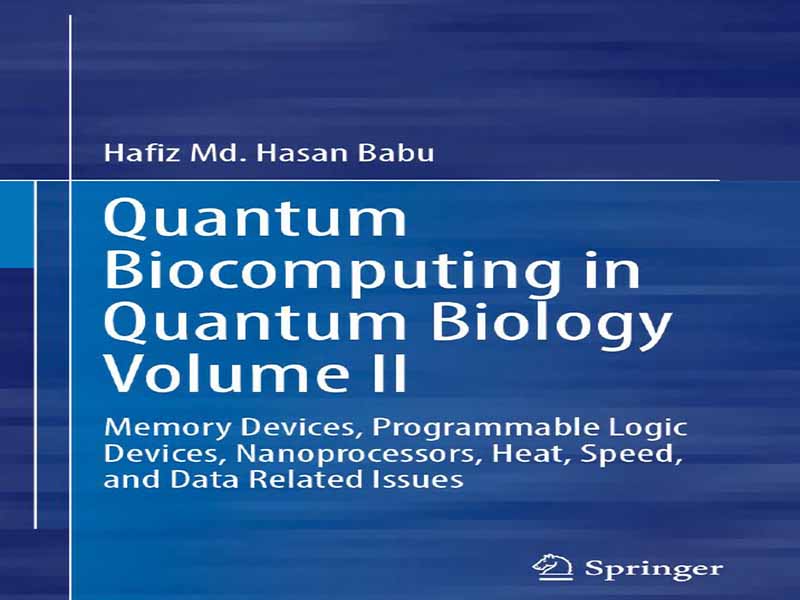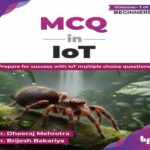- عنوان کتاب: Quantum Biocomputing in Quantum Biology, Volume II
- نویسنده: Hafiz Md. Hasan Babu
- حوزه: محاسبات کوانتومی
- سال انتشار: 2025
- تعداد صفحه: 432
- زبان اصلی: انگلیسی
- نوع فایل: pdf
- حجم فایل: 13.3 مگابایت
زیستشناسی کوانتومی حوزهای از مطالعات است که فرآیندهایی را در موجودات زنده بررسی میکند که نمیتوان آنها را با قوانین کلاسیک فیزیک به طور دقیق توصیف کرد. این بدان معناست که برای درک این فرآیندها باید از نظریه کوانتومی استفاده کرد. همه مواد، از جمله ماده زنده، تابع قوانین فیزیک هستند. زیستشناسی و فرآیندهای بیولوژیکی اغلب با الکترونها و پروتونهایی سروکار دارند که به طور مداوم بین بخشهای مختلف یک سلول یا یک سیستم ماکرومولکولی منتقل میشوند. این فرآیندهای انتقال فقط زمانی میتوانند رخ دهند که سیستم با محیط خود به شکل ارتعاشات مولکولی و فونونها تبادل انرژی کند. چنین سیستمی «سیستم کوانتومی باز» نامیده میشود و قوانین فیزیکی خاصی بر آن اعمال میشود. نمونههای خوبی از فرآیندهای بیولوژیکی که در آنها اثرات کوانتومی قابل مشاهده هستند، انتقال الکترونها و پروتونها در فتوسنتز، تنفس، بینایی، کاتالیز، بویایی و اساساً هر فرآیند انتقال بیولوژیکی دیگر است. نمونههای دیگر شامل انتقال انرژی الکترونیکی و/یا ارتعاشی و اثرات میدان مغناطیسی در انتقال الکترون و مهاجرت پرندگان است. بدون قوانین مکانیک کوانتومی، نمیتوانیم حیات و فرآیندهای حیات را درک کنیم. چالش این است که بفهمیم چگونه در یک محیط مرطوب و پر سر و صدا (مانند یک پروتئین، یک غشاء، یک سلول و یک موجود زنده کامل) قوانین «کامل» فیزیک کوانتومی پابرجا میمانند. در آینده نزدیک شاهد آزمایشهای جدیدی خواهیم بود که به عنوان مثال، اثرات میدانهای مغناطیسی قوی، تجزیه و تحلیل تک مولکول/سیستم و میکروسکوپ همدوس فمتوثانیه را مطالعه خواهند کرد. یکی از چالشها این است که بفهمیم چگونه اثرات کوانتومی، که به وضوح در سطحی از توصیف عملکردی وجود دارند، به مشاهداتی در سطح بالاتری از پیچیدگی تبدیل میشوند. ما شاهد بررسی سیستمهای جدیدی مانند نورونها، شبکههای عصبی و شاید کل مغز خواهیم بود. ما شاهد ارتباط نزدیکتری بین درک بیشتر خود از حیات و درک خود از انفورماتیک کوانتومی، محاسبات کوانتومی، هوش مصنوعی و فناوریهای مختلف دیگر خواهیم بود. محاسبات در زیستشناسی کوانتومی ترکیبی از محاسبات کوانتومی و محاسبات DNA است که برای اولین بار در اینجا معرفی میشود. این یک پلتفرم جدید برای سیستم محاسباتی است که شامل ترکیبی از محاسبات کوانتومی و محاسبات DNA است – میتوان آن را سیستم کراس پلتفرم محاسبات کوانتومی و DNA نامید که میتواند به دو روش انجام شود، یعنی «محاسبات کوانتومی-DNA یا محاسبات زیستی کوانتومی یا محاسبات بیولوژیکی کوانتومی» و «محاسبات کوانتومی-DNA یا محاسبات زیستی کوانتومی یا محاسبات کوانتومی بیولوژیکی». کتاب «محاسبات زیستی کوانتومی: محاسبات در زیستشناسی کوانتومی» با اصول محاسبات کوانتومی، محاسبات زیستی، محاسبات کوانتومی-DNA و محاسبات کوانتومی-DNA در جلد اول آغاز میشود. جلد اول در مورد عملیات اساسی در محاسبات کوانتومی، انواع مختلف مدارهای محاسباتی کوانتومی، عملیات اساسی در محاسبات زیستی، مدارهای محاسباتی DNA، مدارهای محاسباتی کوانتومی-DNA و مدارهای محاسباتی کوانتومی-DNA مانند عملیات دروازه پایه و جهانی، نیم جمعکننده، تمام جمعکننده، نیم تفریقکننده، تفریقکننده کامل، جمعکنندههای Nqubit، ضربکنندهها و تقسیمکنندهها بحث میکند. مدارهای ترکیبی کوانتومی و DNA مختلف، مانند کوانتوم، کوانتوم-DNA و DNA-کوانتوم، رمزگذار، رمزگشا، مالتیپلکسر و دیمالتیپلکسر، نیز در جلد اول این کتاب مورد بحث قرار گرفتهاند. انواع مختلف مدارهای ترتیبی، مانند لچ SR، فلیپ فلاپ SR، فلیپ فلاپ D، فلیپ فلاپ T، فلیپ فلاپ JK، شیفت رجیستر، شمارنده موجی، شمارنده همزمان در محاسبات کوانتومی، کوانتومی-DNA و DNA-کوانتوم. محاسبات در زیستشناسی کوانتومی به معنای تمام محاسبات منطقی در حالتهای محاسبات کوانتومی-DNA و DNA-کوانتوم است. این جلد (جلد دوم) به بررسی معماری و کاربردهای انواع مختلف دستگاههای حافظه، مانند حافظه با دسترسی تصادفی (RAM)، حافظه فقط خواندنی (ROM) و حافظه فقط خواندنی قابل برنامهریزی (PROM)، حافظه نهان در محاسبات کوانتومی، کوانتومی-DNA و DNA-کوانتوم خواهد پرداخت. انواع مختلفی از دستگاههای منطقی قابل برنامهریزی مانند آرایه منطقی قابل برنامهریزی (PLA)، آرایه دروازه قابل برنامهریزی میدانی (FPGA)، دستگاه منطقی قابل برنامهریزی پیچیده (CPLD) در محاسبات کوانتومی، کوانتومی-DNA و DNA-کوانتومی نیز ساخته شدهاند. خوانندگان در مورد طراحی نانوپردازندههای کوانتومی، کوانتومی-DNA و DNA-کوانتومی و اجزای آنها مانند RAM، ثبات دستورالعمل (IR)، شمارنده برنامه (PC)، مدار افزایشدهنده، رمزگشا، مالتیپلکسر، واحد منطق حسابی (ALU) و انباره در محاسبات کوانتومی و محاسبات DNA دانش کسب خواهند کرد. خوانندگان ایده محاسبات کوانتومی، محاسبات کوانتومی-DNA و محاسبات کوانتومی DNA را از سطوح پایه تا پیشرفته دریافت خواهند کرد که به آنها در طراحی مدارهای کوانتومی، کوانتومی-DNA و DNA-کوانتومی جدید کمک خواهد کرد. بخش آخر کتاب به بحث در مورد مسائل مربوط به دادهها، گرما و سرعت در محاسبات زیستی کوانتومی خواهد پرداخت.
Quantum biology is the field of study that investigates processes in living organisms that cannot be accurately described by the classical laws of physics. This means that quantum theory has to be applied to understand those processes. All matter, including living matter, is subject to the laws of physics. Biology and biological processes often deal with electrons and protons that are continuously being transferred between different parts of a cell or a macromolecular system. These transfer processes can only take place when the system exchanges energy with its environment in the form of molecular vibrations and phonons. Such a system is called an ‘open quantum system’, and special physical laws apply to it. Good examples of biological processes in which quantum effects are visible are the transport of electrons and protons in photosynthesis, respiration, vision, catalysis, olfaction, and in basically every other biological transport process. Further examples include the transfer of electronic and/or vibrational energy, and magnetic field effects in electron transfer and bird migration. Without the laws of quantum mechanics, we cannot understand life and life processes. The challenge is to understand how in a wet and noisy environment (such as a protein, a membrane, a cell, and an entire organism) the ‘perfect’ laws of quantum physics survive. In the near future we will see new experiments that will study, for example, the effects of strong magnetic fields, single molecule/system analysis, and femtosecond coherent microscopy. One challenge is to understand how quantum effects, clearly present at some level of functional description, translate into observations at a higher level of complexity. We will see new systems being investigated, such as neurons, neural networks, and maybe the entire brain. We will see a closer connection between our further understanding of life, and our understanding of quantum informatics, quantum computing, artificial intelligence, and various other technologies. Computing in Quantum Biology is the combination of quantum computing and DNA computing which is introduced here for the first time. This is a new platform for the computing system, which consists of a combination of quantum computing and DNA computing—it can be called the cross-platform system of quantum and DNA computing which can be done in two ways, namely, “quantum- DNA computing or quantum biocomputing or quantum biological computing” and “DNA-quantum computing or bioquantum computing or biological quantum computing” The book “Quantum Biocomputing: Computing in Quantum Biology” starts with the basics of Quantum Computing, Biocomputing, Quantum-DNA Computing, and DNA-Quantum Computing in Volume I. Volume I discussed the fundamental operations in quantum computing, different types of quantum arithmetic circuits, fundamental operations in biocomputing, DNA arithmetic circuits, quantum- DNA arithmetic circuits, and DNA-quantum arithmetic circuits such as basic and universal gate operations, half-adder, full-adder, half subtractor, full subtractor, Nqubit adders, multipliers, and dividers. Different quantum and DNA combinational circuits, such as quantum, quantum-DNA and DNA-quantum encoder, decoder, multiplexer, and demultiplexer, have also been discussed in Volume I of this book. Different types of sequential circuits, such as SR-latch, SR flip-flop, D flip-flop, T flip-flop, JK flip-flop, shift register, ripple counter, synchronous counter in quantum, quantum-DNA, and DNA-quantum computing. Computing in quantum biology means all logical computations in quantum-DNA and DNA-quantum computing modes. This volume (Volume II) will discuss the architecture and applications of different types of memory devices, such as Random-Access Memory (RAM), Read- Only Memory (ROM), and Programmable Read-Only Memory (PROM), cache memory in quantum, quantum-DNA, and DNA-quantum computing. Different types of programmable logic devices such as Programmable Logic Array (PLA), Field Programmable Gate Array (FPGA), Complex Programmable Logic Device (CPLD) in quantum, quantum-DNA, and DNA-quantum computing are also constructed. The readers will get knowledge about the designs of quantum, quantum-DNA, and DNAquantum nanoprocessors and their components such as RAM, Instruction Register (IR), Program Counter (PC), incrementor circuit, decoder, multiplexer, Arithmetic Logic Unit (ALU), and accumulator in quantum computing and DNA computing. The readers will get the idea of quantum computing, quantum-DNA computing, and DNA-quantum computing from basic to advanced levels which will help them to design new quantum, quantum-DNA, and DNA-quantum circuits. The last part of the book will discuss the data, heat, and speed-related issues of quantum biocomputing.
این کتاب را میتوانید از لینک زیر بصورت رایگان دانلود کنید:
Download: Quantum Biocomputing in Quantum Biology, Volume II




































نظرات کاربران